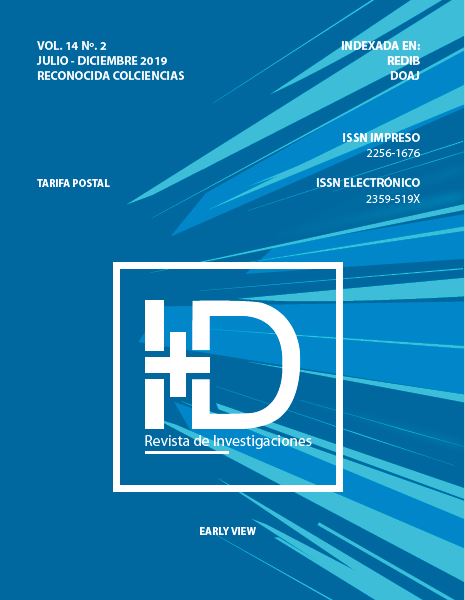Relationship between safety leadership and safety culture in workers of three SMEs in the industrial sector of Bucaramanga
DOI:
https://doi.org/10.33304/revinv.v14n2-2019005Keywords:
Safety culture, Safety climate, SMEs, industrial.Abstract
The safety culture of an organization determines the success in the implementation of the safety and health management system at work. One of the main factors that affect the level of culture in security is leadership in the safety of managers, middle managers and managers of the management system. The results of a study whose objective was to determine the relationship between "Culture in security" and "Leadership in security" in employees of three SMEs the industrial sector are presented. This study has a quantitative, non-experimental, cross-sectional approach of correlational scope. To measure the variables, validated instruments were used in previous studies. It was found that the level of "Culture in security" was determined to a large extent by the level of "Leadership in security" in the three SMEs analyzed.Downloads
References
Agencia Ejecutiva para la Salud y la Seguridad del Reino Unido. (2005). A review of safety culture and safety climate literature for the development of the safety culture inspection toolkit.
Argüello-López, G. M., Uribe Bermúdez, J. M., & Valdivieso Guerrero, M. (2017). Relación entre capacitación y actitud hacia los riesgos laborales en el sector construcción del área metropolitana de Bucaramanga. I+D Revista de Investigaciones, 9(1), 14–26. https://doi.org/10.33304/revinv.v09n1-2017002
Cámara de Comercio de Bucaramanga. (2018a). ADN Sectorial Compite 360.
Cámara de Comercio de Bucaramanga. (2018b). Clasificación por tamaño de las empresas inscritas en Santander.
Cervantes, V. H. (2005). Interpretaciones del coeficiente Alpha de Cronbach. Avances En Medición, 3(1), 9–28.
Comisión de Seguridad y Salud del Reino Unido. (1993). ACSNI Study Group on Human Factors. 3rd Report: Organizing for Safety. Londres, Reino Unido: HSC.
FASECOLDA. (2018). Sistema de Consulta de Información en Riesgos Laborales - RL Datos Riesgos Laborales. Retrieved from https://fasecolda.com/index.php/ramos/riesgos-laborales/documentos-de-interes/
Fernández-Muñiz, B., Montes-Peón, J. M., & Vázquez-Ordás, C. J. (2004). Antecedentes del comportamiento del trabajador ante el riesgo laboral: Un modelo de cultura positiva hacia la seguridad. Revista de Psicología Del Trabajo y de Las Organizaciones, 21(3), 207–234.
Kapp, E. A. (2012). The influence of supervisor leadership practices and perceived group safety climate on employee safety performance. Safety Science, 50(4), 1119–1124. https://doi.org/10.1016/j.ssci.2011.11.011
Kouabenan, D. R., Ngueutsa, R., & Mbaye, S. (2015). Safety climate, perceived risk, and involvement in safety management. Safety Science, 77, 72–79. https://doi.org/10.1016/j.ssci.2015.03.009
Martínez-Oropesa, C., & Cremades, L. V. (2012). Liderazgo y cultura en seguridad: su influencia en los comportamientos de trabajo seguros de los trabajadores. Salud de Los Trabajadores, 20(2), 179–192.
Neal, A., Griffin, M. A., & Hart, P. M. (2000). The impact of organizational climate on safety climate and individual behavior. Safety Science, 34(1–3), 99–109. https://doi.org/10.1016/S0925-7535(00)00008-4
Pidgeon, N. F. (1991). Safety culture and risk management in organizations. Journal of Cross-Cultural Psychology, 22(1), 129–140.
Pucci, F. (2007). Accidentes de trabajo y condiciones de riesgo en la industria de la construcción uruguaya. In La gestión del riesgo y las crisis : personas, culturas organizacionales e instituciones. (pp. 187–224). Buenos Aires, Argentina: FONCSI, Universidad de San Andrés y Editorial El Ateneo.
Puyal-Español, E. (2001). La conducta humana frente a los riesgos laborales: determinantes individuales y grupales. Acciones e Investigaciones Sociales, (12), 157–184.
Rimbau, E. (2013). Liderazgo y prevención de riesgos laborales. Seguridad y Salud En El Trabajo, 75, 10–17.
Vanegas, C., Jiménez, L., Cudris, L., & Redondo, M. (2017). Ausentismo por enfermedad común en empleados de una central de energía -Antioquia. I+D Revista de Investigaciones, 9(1), 116–125. https://doi.org/10.33304/revinv.v09n1-2017011












